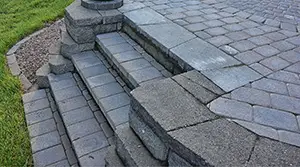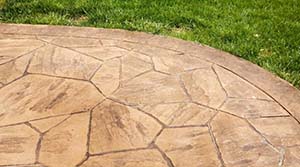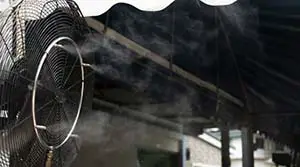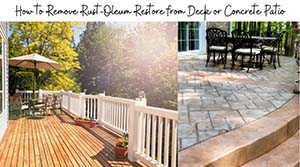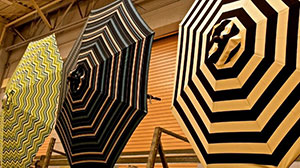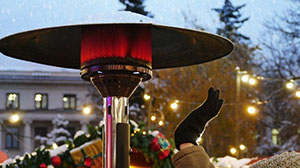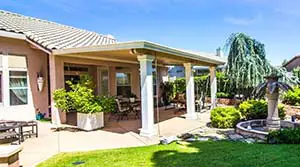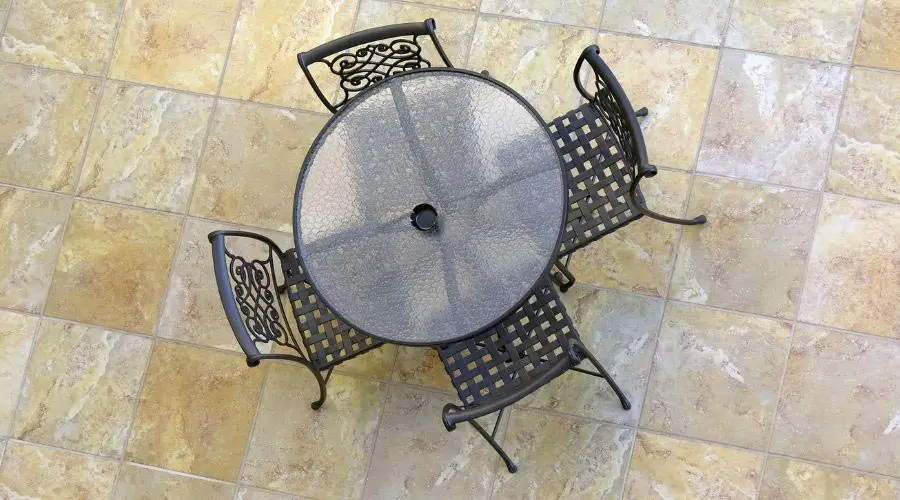
Having outdoor furniture is a great way to make your house feel like a home. It gives plenty of space for friends and family to sit when you’re entertaining, having picnics, or seasonal get-togethers.
There are multiple ways to clean mesh patio furniture, and it will depend on what you have on hand or are willing to purchase. However, the elements can quickly turn pristine-looking outdoor furniture into algae and mildew-covered messes.
You can use water mixtures with vinegar, detergent, various cleaning solutions, or some types of bleach to remove algae, mildew, and other seasonal stains to make your outdoor furniture look new again.
Cleaning mesh patio furniture can take you forever when not handled, or you have further knowledge about it. With different possible causes, here are some helpful tips to get your mesh patio furniture clean in no time!
How Do You Remove Mildew from Mesh Outdoor Furniture?
Mildew on outdoor furniture is prevalent in most areas, especially if you have hot and humid temperatures and your patio furniture is kept under the shade most of the time.
Mildew shows up as a white powdery substance that sticks to furniture mesh and some frames as well. You’ll often notice it starting to grow and may be able to dust it off of the furniture with your hand or a brush.
Over time, the mildew will grow and take more of a hold on the furniture. It will turn a yellowish or brown color and will resemble mold.
If you are left to multiply on your table and continue to use that furniture, you can experience health issues over time. Mildew can cause headaches, respiratory problems, and lung disease over extended periods.
Mildew is usually easy to remove from mesh outdoor furniture, although it grows between seasons. If ever you haven’t cleaned your movable at all in many months or years, it might require a bit more elbow grease from you.
It might also need a few different cleaning treatments to ensure you have removed all of the mildew spores so they don’t start growing again in the future.
Here are ways to remove mildew from mesh outdoor furniture:
1. For Fabric Mesh
- The first step is to give the furniture a dry scrub down with a brush to help remove most of the dirt and dry powdery mildew spores.
- After that has been done, mix your cleaning solution. This can be a 1:1 ratio of warm water with dishwashing soap, powdered laundry detergent, or even shampoo.
- Mix the cleaning solution. It does not matter if you create bubbles with the solution, as it will still provide the same cleaning effect.
- Use a thick rag or scrubbing sponge to scrub the cleaning solution into the fabric mesh of the outdoor furniture. Ensure you thoroughly soak it down and wash it well.
- Once the furniture has been thoroughly scrubbed, use clean water to rinse it down. You can use a garden hose with a pressure nozzle as well to help give a deep rinse.
- Allow the furniture to be sundry. If you still notice mildew stains after it has dried, repeat the cleaning process as needed.
2. For Plastic Mesh
- Start as you would with the fabric mesh; by removing surface dust and some dry mildew with a brush or scrubbing pad.
- Mix one gallon of warm water with one-half cup of color-safe bleach. You can also use Oxyclean brand detergent powder if you prefer.
- Ensure the powder has dissolved completely in the water before you start to use it for cleaning. Since you are using bleach products, always mix these in a well-ventilated area.
- Use a cloth rag or soft sponge to wipe the cleaning solution onto the surfaces of the furniture. Be sure to take your time and let the bleach sit on the surfaces for a few minutes to ensure it has a chance to clean the mildew thoroughly.
- After you are satisfied with the clean, use warm water to rinse away the bleach cleaning solution. Warm water is better than cold water from a garden hose.
- After the chair is rinsed, allow it to sundry for a few hours. If you still notice mildew stains at this time, don’t be afraid to repeat the process as needed.
How Do You Remove Algae from Patio Furniture?
Algae is very common in hot and humid climates. However, unlike mold and mildew, algae are not harmful to your health. It can still be very unsightly when it covers your outdoor furniture, though. Removing algae is not tricky, and there is a wide range of ways you can approach the situation.
3. A Solution of Water & Dish Soap
One of the cheapest ways to remove algae and the stains it causes is by using water and dish soap. Almost everyone has some dish detergent or liquid soap of some kind in their home, and any brand will work just fine.
- Place a few drops of soap into a gallon of warm water and give it a quick shake or two.
- You can then use a spray bottle to apply the cleaning mixture or dip a rag or sponge into the bucket and go from there.
- This should remove most live algae as well as algae stains.
- Remember to rinse the furniture down with water from your garden hose and repeat the process as necessary.
4. Use Vinegar to Kill Algae Growth
If dish soap does not leave your furniture clean and sparkling, you can try a vinegar solution. Vinegar has a low pH and high acid level, which can quickly kill algae growth and remove the stains from your furniture.
- Mix a 1:1 ratio of water and vinegar together. You can also try mixing up smaller ratios of vinegar if you are afraid a 1:1 ratio may discolor your furniture.
- Dip a scrub brush or rough sponge into the mixture and give the algae area a good scrubbing. You can also use a soft sponge if you are afraid the bristles on a brush might damage the surface.
- Periodically re-dip the cleaning apparatus into the bucket of cleaning solution and continue removing as many algae as you can.
- Rinse the furniture thoroughly and repeat the process as needed to ensure the algae does not return.
5. Create a Vinegar & Baking Soda Mixture
If both dish soap and vinegar have failed to remove the stains, or if the algae keep returning in the same spots, you can try a more aggressive approach.
- Mix two parts of vinegar to one part of water and give it a shake. Add in two or three heaping tablespoons of baking soda and mix until the baking soda has dissolved.
- Soak a sponge in the cleaning solution and apply it liberally to the algae stains on your furniture. Let it sit and soak in for 10 minutes.
- After that time has passed, dip the sponge again and now scrub the area. Rinse it thoroughly and check for algae. If any remains, repeat the process.
- Let the furniture dry in direct sunlight for the remainder of the day to help remove the last bit of algae that may be clinging on.
6. Baking Soda
Most people have baking soda in their kitchen pantry, making it an affordable and highly effective cleaning agent. It’s excellent for removing stubborn stains on your patio furniture, and it’s effortless to use too.
Sprinkle some baking soda on a wet sponge and scrub the area with circular motions. Make sure to focus on the stain, but don’t add too much pressure if the fabric is delicate.
Baking soda works fine on both fabric and plastic mesh furniture and will not harm colored fabrics either.
After you are satisfied with the amount of scrubbing, rinse the area with water and give it a look. If the stain remains, repeat the process as needed until you are satisfied. You can also leave the
baking soda and water mixture to sit on the spot while you do something else for a bit.
7. Distilled Vinegar
Distilled vinegar is an excellent choice for cleaning general dirt and grime from your outdoor mesh furniture. It can also be an effective cleaning agent for mold and mildew due to its low pH and high acidity.
It would be best if you never sprayed vinegar directly onto the furniture in its full strength. Instead, dilute it with some warm water.
You can mix it in a 1:1 ratio, though it’s usually better to start with a gallon of water and one cup of vinegar first. If it does not seem practical, you can increase the vinegar amount until you are satisfied.
Some fabric mesh may not stand up well to vinegar due to the level of acidity it has. When in doubt, always test a small area of the furniture first.
If it shows any discoloration or structural weakness after being scrubbed with vinegar, it would be better to use a standard soap detergent to clean that particular piece of furniture.
8. Bleach
Bleach is excellent for laundry loads but can also be highly effective at removing tough stains from patio furniture. It’s handy for grass stains, mold, mildew, and wine.
One of the biggest concerns with bleach is that you should never use chlorine-based bleach. Always be sure to use color-safe bleach or oxygen-based bleach cleaners such as Oxyclean. It will remove colors from your fabrics in a short time.
If you are unsure what type of bleach you have on hand, test it on a small and discreet spot of your furniture first. Give it some time to sit, then rinse it off. If it has not discolored the fabric after 2 hours, it should be color-safe and good bleach to use.
9. Rubbing Alcohol
Rubbing alcohol is an excellent option for removing specific stains such as grease, grass, oil, lipstick, and mustard.
However, it should only be used occasionally and should not be your only or regular-use cleaning agent. If used too much, it can fade or discolor fabrics.
For stain removal, dab the area with a small amount of alcohol and let it sit for 5 minutes. You can rub the spot gently while the alcohol sits, or you can let it sit undisturbed, then rub the area after 5 minutes. Either way, you should notice the stain fading away within a short amount of time.
However, always try other cleaning methods before you reach for the rubbing alcohol for the safest use. It is a very effective cleaning agent, and you should save it as a last resort option for stains that other methods won’t remove.
Other Furniture Materials
Teak Wood & Wicker Furniture
Keeping your teak and wicker furniture clean is much easier when doing it in a preventative method. Please give it a good cleaning once a month with a soft brush or rag using a standard water and dish soap mixture. There’s no need for harsh chemicals or bleach on these slightly more delicate materials.
Wrought Iron & Aluminum Furniture
Unfortunately, wrought iron and aluminum furniture seem to be more prone to picking up seasonal stains than other materials.
However, you can use any cleaning agent of your choice on both metals without any issues. It would help if you always started with a soap and water mixture before moving into bleach or alcohol mixtures.
Cushions & Pillows
Outdoor furniture has a lot of fabric on it, and it’s sometimes hard to know how durable this fabric is. When cleaning seat cushions or pillows on your outdoor furniture, you can use a borax and soap mixture for the ultimate cleaning power.
With one gallon of water, add two tablespoons of any dish soap and one-half cup of Borax powder. Let the solution sit for 20 minutes to ensure the borax has dissolved before you spot clean your fabrics with it.
Conclusion
Having outdoor furniture can make your patio or yard look great. It creates your little outdoor oasis with plenty of room to entertain friends and family.
But mold, mildew, algae, and other seasonal debris can cause stains to your favorite furniture. Learning how to clean these surfaces safely and effectively can return your outdoor furniture to its former glory!
Sources

